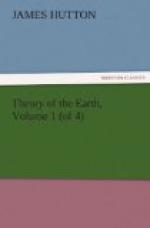We see the very same thing happen under our eye, and precisely in the same manner. When a fluid mass of any mineral or metallic substance is made to congeal by sudden cooling on the outside, while the mass within is fluid, a cavity is thus sometimes formed by the contraction of the contained fluid; and in this cavity are found artificial druzen, as they may be called, being crystallizations similar to those which the mineral cavities exhibit in such beauty and perfection.
Petrification and consolidation, in some degree, may doubtless be performed, in certain circumstances, by means of the solution of calcareous earth; but the examples given by M. de Luc, of those bodies of lime-stone and agate petrified in the middle of strata of loose or sandy materials, are certainly inexplicable upon any other principle except the fusion of those substances with which the bodies are petrified[35].
[Note 35: Vid. Lettre 28 et Lettre 103. Lettres Physiques et Morales.]
This subject deserves the strictest attention; I propose it as a touchstone for every theory of petrification or perfect consolidation. First, There are found, among argillaceous strata, insulated bodies of iron-stone, perfectly consolidated; secondly, There are found, in strata of chalk and lime-stone, masses of insulated flints; thirdly, There are found, in strata of sea sand, masses of that sand cemented by a siliceous substance; fourthly, In the midst of blocks of sand-stone, there are found masses of loose or pure sand inclosed in crystallised cavities; and in this sand are found insulated masses of crystallised spar, including within them the sand, but without having the sparry or calcareous crystallization disturbed by it. There are also other globular masses of the same kind, where the sparry crystallization is either not to be observed, or appears only partially[36]: And now, lastly, In strata of shell-sand, there are found masses of consolidated lime-stone or marble. In all those cases, the consolidated bodies are perfectly insulated in the middle of strata, in which they must of necessity have been petrified or consolidated; the stratum around the bodies has not been affected by the petrifying substance, as there is not any vestige of it there; and here are examples of different substances, all conspiring to prove one uniform truth. Therefore, a general theory of petrification or consolidation of mineral bodies must explain this distinct fact, and not suffer it any longer to remain a lusus naturae.
[Note 36: Mem. de l’Academie Royale des Sciences, an. 1775.]
Let us now consider what it is that we have to explain, upon the supposition of those concretions being formed from a solution. We have, first, To understand what sort of a solution had been employed for the introducing of those various substances; secondly, How those concretions had been formed from such solutions within those bodies of strata; and, lastly, How such concretions could have been formed, without any vestige appearing of the same substance, or of the same operation, in the surrounding part of the stratum. Whatever may be the difficulty of explaining those particular appearances by means of fusion and mechanical force, it is plainly impossible to conceive those bodies formed in those places by infiltration, or any manner of concretion from a state of solution.




